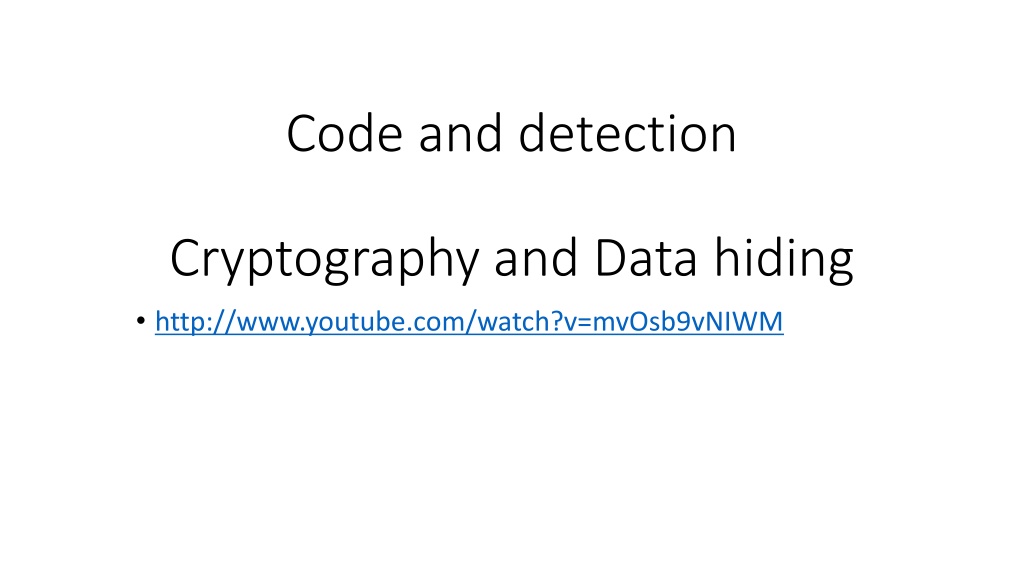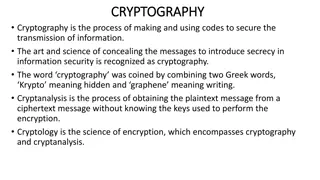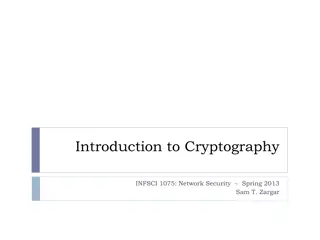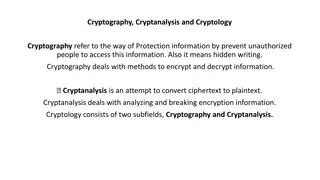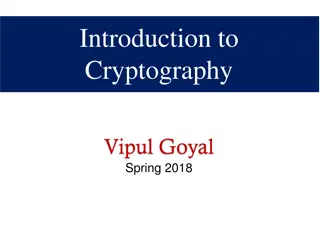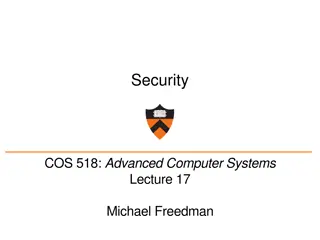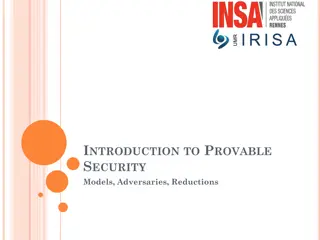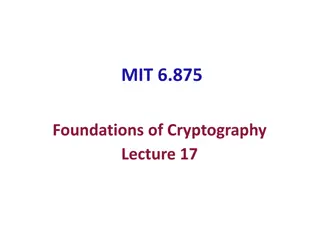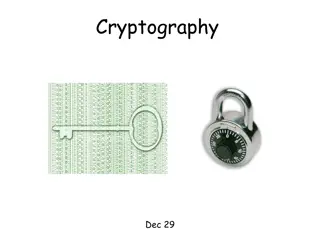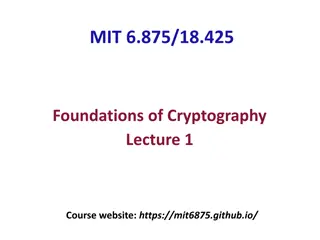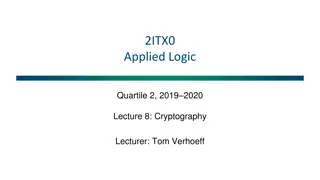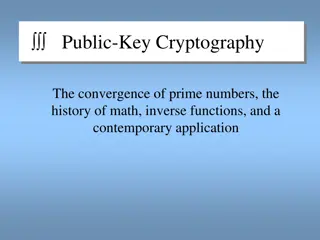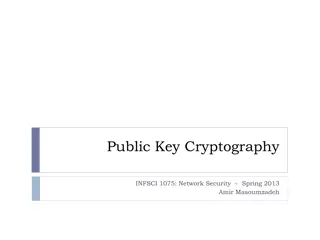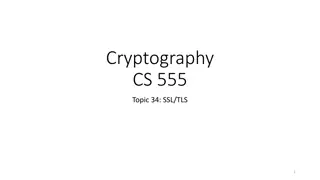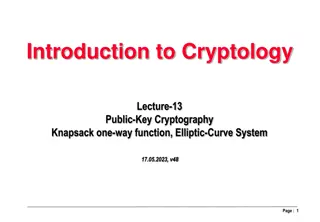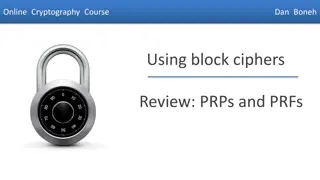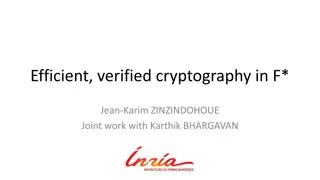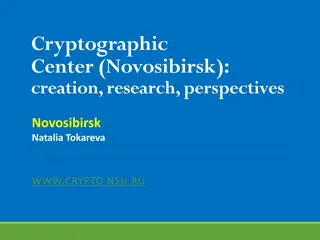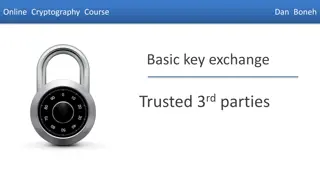Exploration of Cryptography and Secure Communication Methods
Delve into the concepts of cryptography, data hiding, and secure communication methods such as Diffie-Hellman key exchange. Discover how Bob safely sends a ring to Alice, the use of Caesar cipher method, and the importance of mathematical principles in ensuring secure communication protocols. Learn about the challenges and solutions in maintaining data security and confidentiality in digital communication.
Download Presentation

Please find below an Image/Link to download the presentation.
The content on the website is provided AS IS for your information and personal use only. It may not be sold, licensed, or shared on other websites without obtaining consent from the author. Download presentation by click this link. If you encounter any issues during the download, it is possible that the publisher has removed the file from their server.
E N D
Presentation Transcript
Code and detection Cryptography and Data hiding http://www.youtube.com/watch?v=mvOsb9vNIWM
Secure mail; Engage ring exchange Bob want to send engage ring to Alice. But they live far away, and he need to mail it. Unfortunately, in their country , mail is always stolen unless it is in a box locked by a padlock. Each of Bob and Alice has many padlocks, but has no key for padlocks of each other. How Bob safely send the ring (or a pair of his padlock and key) to Alice??
Diffie-Hellman system Whitfield Diffie was captured the idea of the secure key exchange He want to turn the Alice-Bob puzzle to the secure network protocol Martin Hellman joined him, and find a way by using elementary number theory. Diffie was a kind of hippy -type researcher and Helman was a professor of Stanford
Secure mail quiz: A solution Bob send the ring in a box with his padlock Alice receive it, set her padlock too, and send back to Bob Bob unlock his padlock and send back to Alice Alice unlock her padlock. Smile! Easy (if once shown), but very inspiring.
Use Caeser method? Apply key exchange Alice want to send M = ILOVEYOU Her key is 14312431 ,and send A= JORWGCRV to Bob Bob use his key 21121141 and send B= LPSYHDVW to Alice Alice unlock her key by -1,-4,-3,-1,-2,-4,-3,-1 to send C= KMPXFZSW to Bob Bob unlock is key to have D= ILOVEYOU . Smile?? What is wrong??.
Breaking the protocol Takeshi knows A, B, and C k and k are keys of Alice and Bob A = M k, : component-wise summation) B = A k = M k k C= B (-k) = M k Takeshi can compute M = A C (-B) ,breaking the protocol
Mathematics God blessed Diffie and Hellman Never give up, then god will help you. Mod p computation for a large prime p We use the following facts (proofs later): Given an n bit number x and a number g < p, we can compute g xmod p efficiently . Given an n bit number x , we can compute x such that gxx = g mod p efficiently. But, given g and h, it is difficult to find z such that h=gz How to use it??
Bob send M=I Love You Alice and Bob agrees a prime number p p is known in public, and it is larger than 2500 The message M is a k-bite number < p Alice and Bob has keys x and y, respectively. Both are private. Protocol Alice sends A= M x to Bob Bob reply B = A y to Alice Alice compute C= C x and send it to Bob Bob compute D = C y , which is indeed M Takeshi knows A,B, and C but cannot compute M .
Algorithmic problems we assumed How to compute a large power (mod p) How to find inverse mod p? Euclid s algorithm for largest common divisor How to find a large prime number? Prime number theorem: distribution of random numbers Primarity check
How to find the decryption key x for x Reduce to find inverse mod p-1 Find x such that xx = 1 mod p-1 We assume that we select x so that GCD (x, p-1) = 1. We use gp-1= 1 mod p if g is not zero mod p g xx = g 1+k(p-1) = g Computation of x (say, x=1137 and p-1= 3928) Use Euclid s algorithm to compute the largest common divisor of 1137 and 3928.
How to find inverse mod p Find the largest common divisor of 1137 and 3928? 3928 = 3*1137 + 517 1137= 2*517 + 103 517= 5*103 +2 103 = 51*2+ 1 GCD(1137, 3928)=1 Euclid s algorithm (2300 years ago)
How to find inverse mod (p-1) Find inverse of 1137 mod 3928 GCD(1137, 2791)=1 103 = 51*2+ 1 103- 51*2=1 517= 5*103 +2 103 51*(517-5*103)=1 256*103 - 51*517 =1 1137= 2*517 + 103 256*(1137-2*517)-51*517=1 256*1137 563*517=1 2791 = 3*1137 + 517 256*1137-563(2791-2*1137)=1 1382*1137 563*2791=1 1382*1137 mod 3928= 1, thus 1382 is the inverse mod p-1 Thus Mxx = M 1+k(p-1) mod p = M mod p (Why?)
How to compute large power? Compute 3 92mod 317
How to compute large power? Compute 3 52mod 61 32= 9 34= 81= 20 mod 61 38= 20*20=400 = 34 mod 61 316= 34*34= 1156 = 58 = -3 mod 61 332= (-3)*(-3)= 9 mod 61 352= 332* 316* 34= 9* (-3) *20 = 9*(-60) = 9 mod 61
How to check primarily If P is a prime number, then For any number x, x p = x mod p Fermat s little theorem (but great theorem) We need a little more mathematics, but the current primarily check is based on it.
Better protocol: RSA encription Bob picks two large prime p and q, and compute n = pq Bob picks a number e such that GCD(e, (p-1)(q-1))= 1 Bob computes a number d such that de = 1 mod (p-1)(q-1) Bob publishes n and e in public Alice (or anyone) want to send M < n to Bob Alice computes A = Me mod n and send to Bob Bob computes Admod n, which is indeed M.
Story about RSA cryptosystem RSA (Rivest-Shamir-Adelman) invented in 1977, following the idea of Diffie-Hellman in 1976. But, it is believed that it was invented before. James Ellis found the idea in 1969 inspired by an old (1944?) paper Clifford Cocks found a protocol equivalent to RSA in 1973 Diffie-Hellman protocol was also found earlier. But, they could not publish it, since they worked in GCHQ I did not know until late 90 s
How to distribute a secret (Reed-Solomon code) Captain Flint will be arrested next morning, and would like to send letters to his followers to teach the secret location of treasure island. However, he consider the risk of someone will steal the treasure (or someone will be arrested to confess the secret). He wants that the secret will be revealed if any of five among seven followers will gather and share their letters. No clue should be revealed if less than five followers meet (or are arrested) Give your advice to the captain.
Reed Solomon code Let a0, a1, a2, ,an-1be n numbers (each has k bits length) Consider the function ? ? = ?=0 ? ???? Make pair ( t, F(t)) for t= 1,2,3, , m (m > n) If we have n pairs, we can retrieve a0,..,an-1 You can do computation in finite field (mod p for large p)
Coin flipping 64 coins are located on a chess board choosing face or tail Alice tells Bob a cell (say, D7) of the chessboard Bob is allowed to flip one coin (he may do nothing) Bob leaves the room. Alice can align, but cannot flip any coin Charlie comes in, sees the coins on the board If Charlie can answer the location (D7), Bob-Charlie win Otherwise, they fail Give a strategy for Bob&Charlie
Nim game Two player changes three piles of stones (say, 6,2,4) in turn Each player subtract any number of stones from one pile. The player clears the stones wins (there is a version that he loses) What is your tactics Do you want to play first for (6,2,4)? Flash game
Red-blue hat again You are a team of N students. Each student are given red or blue hats randomly (with probability 0.5 red) All the students shout red or blue or pass simultaneously. If any student says wrong color, the team fails. If all students say pass , the team fails. In other words, at least one student says a color, and all students saying a color are correct, the team wins. If N = 3, can you imagine a good strategy of the team? If N = 7, what to do? Hint: Perfect win is not possible. Please increase the winning probability.
